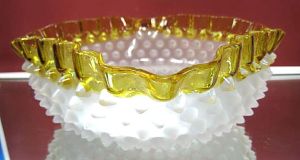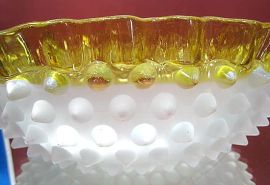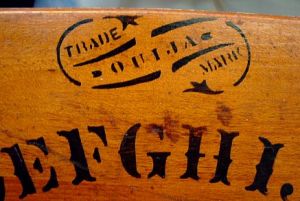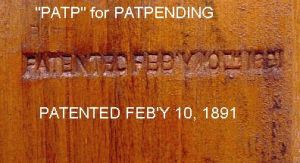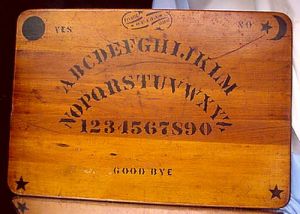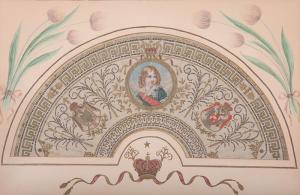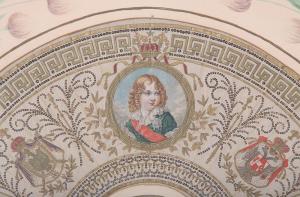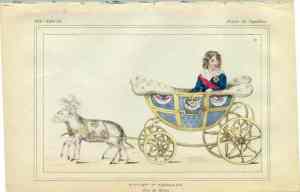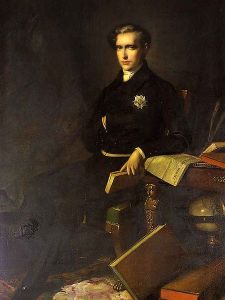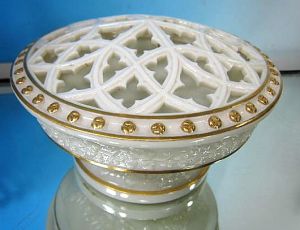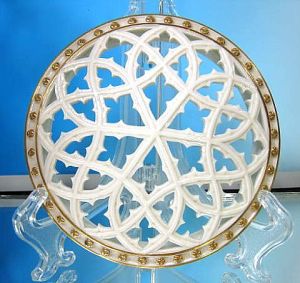I wish all of you, and the world, a better, brighter, and much happier 2013!
Archive | December 2012
What The Heck Is Frances On EAPG Glass?
There is an Early American Pressed Pattern Glass, also called EAPG, that has a special addition to the rim edge. It was an amber yellow, wide border, that was most often ruffled in appearance, although it could also be flat. The glass was made by the company Hobbs, Brockunier & Co, and they made many highly collectible patterns, including Hobnail, which they called “Dewdrop”.
I had learned that the yellow border was known as, “Frances”, but could not find out why. It literally took me years to finally discover the origins of the name.
In June, 1886, 49 year old American President Grover Cleveland, a lifelong bachelor, married his ward, 21 year old Frances Folsom in the White House, and eventually had five children.
In my endless research, I finally came across two references that spoke of the company as having created the hand crimped, annealed on yellow border and having named it “Frances”, as in “Dewdrop With Frances” in honor of the First Lady Frances Cleveland.
Now I know and understand that learning about this is of no true importance, but as I’ve often said, I love mysteries, and hate unsolved history. So now you, too, know that when anything refers to having a Frances border, it is an annealed, amber yellow, wide glass border, named for the wife of an American President!
OK, I Finally Did It
I HATE writing or talking about myself. But I see there have been so many “hits” on the “ABOUT ME” page, which was empty, that I finally spent the entire day, and even some of the evening, writing enough (more than enough, in my opinion) to fill up the page.

Two Inia geofrenisis (Amazon River) dolphins with whom I worked at the Duisbirg Zoo, in Duisburg, Germany
I actually have a done a few things that were unrelated to antiques or Enchanted bowls.
If you have a minute, please drop by and have a look.
Thanks!
A Very Painful Time
In Memorium
We live In Bridgewater, CT. My husband works in Newtown, CT, and Sandy Hook is part of Newtown. The Sandy Hook Elementary School is literally 10 miles from us.
We are all in shock and deeply sorrowful for the children and adults who lost their lives yesterday. I have always felt the terrible emotional pains of those who have experienced such mass tragedies. But this is so very close to where we live, and the hurt in our hearts is literally a physical pain.
It is of small consequence that we send our sympathies to the relatives of the twenty children who were massacred, and to the families of the adults who died trying to protect and save the students.
Extra Rare – Ouija Board – Part Two
I don’t know about other folks who sell antiques, but I do know what I do. I not only check things out for condition (chips, niks, fliks, hairlines, cracks, repairs, and so on) I also look for anything that might be unusual, or of historical importance. Should I find something, then, like a dog worrying a bone, I have to track it down until I’m thoroughly satisfied with what I’ve learned (see the Napoleon Fan Leaf blog).
When I looked closely at the back side of the board. The construction was very different from even the other older ones I’d seen; more primitive in look and feel. Then I used a magnifier to get a better look at the impressed mark(s) on the wood. There were two, something that was very unusual, because one was directly on top of the other.
The first one read: PatP – for Patent Pending. But on top of that there was a completely different mark, and while the first had been made using a precut die stamp, the second one clearly was done using individual letters and numbers to create the mark. On the front, it was missing the word, “TRADEMARK”, that later boards carried.
This meant that the information was too new for a die stamp to have been created, and it meant that the information had to have arrived just after the PatP stamp had been used. In other words, this was the very Ouija board that had been under construction at the exact moment that the news of their having been granted a patent had been received.
Double checking the information in the Museum of the Talking Board website, I saw that the date of February 10, 1891, which they said the company had received the patent, matched the date on the hand made die stamp mark. As a shortcut, they had hand stamped it FEB’Y 10, 1891, but they had used individual letters and numbers, rather than a single stamp that said everything.
This meant that this was THE ONE board that existed which showed the time when, at first, it did not have a patent, and then it did. It may not have been of earthshaking importance, but as a former history teacher and a former researcher in communication, I was well aware of how significant this would be to someone who was interested in such things.
It sold for an amazing amount, one I would never forget – $1,234.56 – 1,2,3,4,5,6! But even better, it was restored into the world as being exactly what it was. I have always felt that there was a reason it came to me, rather than someone else. Clearly I was the one person who would have, and who could have figured out its true history.
Extra Rare – Ouija Board – Part One
I love to find hidden treasures. When I did research in communication with dolphins for 19 years I was a professional scuba diver (P.A.D.I. Divemaster).
I occasionally joined in with other organizations to help on projects that were associated with underwater archaeology, so dissevering rare things on dry land is quite consistent for a researcher such as myself.
The story of this Ouija board is rather long, so I will break it into two blogs, just so you won’t feel like you’re reading a book.
I was at an auction in northern Connecticut. Although I usually only have eyes for porcelain and glass, I actually tripped over a large board of wood. When I bent over to pick it up, I was surprised to see a huge Ouija board in a style and shape I’d never seen before. I couldn’t resist, and even though the auction was an hour and a half away from my home, we stayed until 11 P.M. just to bid on it.
There was little competition, because most people were creeped out that it was a mystical item. On the other hand, I saw it as something so unique that I was sure it had to have an interesting history and story behind it. The story I never found out about, but the history, well that was the most fascinating part of everything.
I am a patient person. I will hold onto an item and do research until I can correctly identify it, or until a website on the Internet finally adds information that I can use. As I checked throughout the Internet, I eventually came across a fascinating place, called The Museum Of The Talking Board. It’s a really fun site, and they even use a planchette as a pointer. You might want to take a “walk” through it when you have a few extra minutes to spend.
If you go here, to the history of the board, you will see information about Charles Kennard and when he received the first patent for the Ouija board: http://www.museumoftalkingboards.com/history.html
It was there that I was able to identify the exact board I had, and why it was significant to the history of the game! This might be a hint: “The first patent for “improvements,” filed on May 28, 1890 and granted on February 10, 1891, lists Elijah J. Bond as the inventor and the assignees as Charles W. Kennard and William H. A. Maupin of Baltimore, Maryland.”
Can you guess what it is?
One Of A Kind Rare
Every know and then I’m fortunate enough to acquire something extremely rare, and of undoubted museum quality. When this happens I do extensive and in-depth research to make certain that what I’m saying about the item is accurate. This silk fan leaf is one of those amazing acquisitions that makes the life of an antiques dealer terribly exciting. I loved doing the research into its history, and here’s what I discovered.
This silk fan leaf is all hand painted and is signed C. G. Bastien on the lower right of the leaf. Other than the two coats of arms, and part of them, and the full color cameo in the center, everything is hand painted in gold paint, with VERY fine strokes. All of the little paillettes (sequins) are very tiny and in the right light, they display in a gold color. They have been hand applied, and are spaced so that when the fabric is folded, they wouldn’t be on the creases. The painted designs and the paillettes form an extremely intricate pattern, one that only an expert would have created.
In the center in a cameo of a little boy, wearing a sash with a medal of state and rank. To the left is a coat of arms, which would have belonged to the father. To the right is a coat of arms that would have belonged to the mother. When I began doing the research on this I started with the one on the right side, that of the mother, because the double headed eagle would have been easier to identify. I discovered that this one belonged to the house of Francis I, Emperor of Austria, and a Habsburg.
From there I was able to identify that this was also an indication that the mother had to have been the daughter of Austrian Emperor Francis I, Empress Marie-Louise, a former Archduchess of Austria. Then I was able to quickly identify the father from the coat of arms on the left. It belonged to none other than Emperor Napoleon I, of France, and Marie Louise had been his second wife. With this, it was easy to then pinpoint the child as being his son, Napoleon II. What made the identification even easier was that in my search, I discovered a colored print of a child sitting in a baby coach that was drawn by two sheep. This was none other than Napoleon II, and it was a version of the cameo in the center of the fan. Bingo! As the child in the cameo was about two years of age, then it was also simple to come up with a date. Because the coats of arms were done by hand, they are only slightly different from the actual ones, but this can be credited to the artist taking artistic license to create this work of art. There is absolutely no doubt what the coats of arms are and who they represent.
About Napoleon II:
Napoleon II led a short and unhappy life. If you go online I’m sure you will be able to find out as much about his as I did, so I won’t repeat the in-depth information here. He was born on March 20, 1811, and died from tuberculosis on July 22, 1832. He never married. His full name was Napoléon François Joseph Charles Bonaparte, and he bore the titles, Emperor Napoléon II Of France, King Of Rome, Prince Imperial, and Duke Of Reichstadt. His mother couldn’t have cared less about him, but he was adored by his father and his maternal grandfather.
A fan carrying both coats of arms would NOT have been in the possession of, or been used by anyone other than a close member of the family, and from the exceptionally fine details, I’m thinking that it was almost surely owned by his mother. Regardless of this, the leaf speaks for itself, and is not only a one of a kind piece, but is of museum quality!
Price available upon request
Hidden Treasure – Celtic Design Vase
Sorry for not getting something new up sooner. I have been working on the Enchanted Environments to get things right, so they will look great here. http://enchantedenvironments.wordpress.com/blogs/
I promise I will add some great new content for you this week.
This Grainger bowl (made between 1870 to 1879) goes up this week starting on 12-9-2012, and it’s stunning. The company was eventually acquired by Royal Worcester. The lid was all hand picked out (pierced, also called reticulated!) It was almost surely done by Alfred Barry, who did most of the reticulation work for Grainger.
I’ve had it for some time, originally thinking it was Lenox, which is why I waited to list it. Lenox is a mass produced American porcelain. But when I saw the impressed mark on the bottom of the foot, I did a lot of research and discovered it was a very fine antique treasure, made over a very limited period of time.
The creamy ivory colored lid was first hand inscribed when the porcelain was still wet and unfired. The Celtic design is made up of thorny vines that intertwine to create the pattern. Then it was fired in a kiln, and hand painted with gold accents.
The side of the bowl has a raised running border of flowers (another reason why I believe this is a vase with a frog) while the lower area has raised grasses. They just don’t make things like this anymore!
Some call it a potpourri, but because of how open the lid work is, and the raised designs, I truly believe it’s a low vase with a flower frog. Either way, it’s a beauty!
Thanks for dropping by.
Sorry, but this is no longer available as if was purchased.

